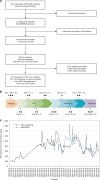Hemolysis contributes to anemia during long-duration space flight
- PMID: 35031790
- PMCID: PMC8799460
- DOI: 10.1038/s41591-021-01637-7
Hemolysis contributes to anemia during long-duration space flight
Abstract
Anemia in astronauts has been noted since the first space missions, but the mechanisms contributing to anemia in space flight have remained unclear. Here, we show that space flight is associated with persistently increased levels of products of hemoglobin degradation, carbon monoxide in alveolar air and iron in serum, in 14 astronauts throughout their 6-month missions onboard the International Space Station. One year after landing, erythrocytic effects persisted, including increased levels of hemolysis, reticulocytosis and hemoglobin. These findings suggest that the destruction of red blood cells, termed hemolysis, is a primary effect of microgravity in space flight and support the hypothesis that the anemia associated with space flight is a hemolytic condition that should be considered in the screening and monitoring of both astronauts and space tourists.
© 2022. The Author(s).
Conflict of interest statement
The authors declare no competing interests.
Figures


References
Publication types
MeSH terms
Substances
LinkOut - more resources
Full Text Sources
Medical

